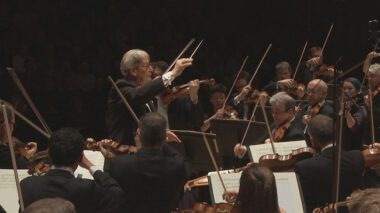 United Kingdom Beethoven: Maria João Pires (piano), London Symphony Orchestra / Sir John Eliot Gardiner (conductor). Barbican Hall, London, 30.6.2022. (KMcD)
United Kingdom Beethoven: Maria João Pires (piano), London Symphony Orchestra / Sir John Eliot Gardiner (conductor). Barbican Hall, London, 30.6.2022. (KMcD)

Beethoven – Leonore Overture No.2; Piano Concerto No.3; Symphony No.4
A concert dedicated to a single composer is something of a rarity these days. We have become used to eclectic programming, so on paper at least this evening of Beethoven appeared to harken back to times of yore. However, when the music-making in question is in the hands of conductor Sir John Eliot Gardiner, you are guaranteed that the results will be far from routine. And this was precisely the case as he steered the London Symphony Orchestra through three of the composer’s key works in the Barbican Hall.
All Gardiner’s period-practice trademarks were present – lean, vibrato-less string playing, clipped phrasing, and timpani hit with hard sticks. Of course it probably does not need saying – the LSO is not a period band, so this hybrid approach inevitably came with a few drawbacks. The rasping sound and visceral excitement of hearing valveless horns and trumpets simply can’t be emulated by their modern-day equivalents, and the same goes for the woodwind as well. Still, given these constraints, all sections of the orchestra embraced Gardiner’s fiery take on Beethoven as a visionary and iconoclast, with each of the works on the programme coming across as freshly-minted.
Beethoven tinkered with his opera Leonore, which later became Fidelio, for many years and in the process rewrote the overture several times – leaving behind four versions at his death. The second and third are more likely to be encountered in the concert hall rather than the opera house these days, with several commentators arguing that both were precursors to the nineteenth century tone poem. Leonore No.2 may be architecturally looser than its successor, but its vivid depiction of Florestan’s prison cell, his rescue at the hands of his wife Leonore, and the ensuing joy at their reconciliation was deftly handled by Gardiner and his forces. There were plenty of the thrills in the hell-for-leather finale, preceded by some genuine theatrical frisson from the off-stage trumpet calls which herald the couple’s release.
Originally scheduled to perform the Piano Concerto No.2, injury forced Maria João Pires to opt instead for the composer’s third. Less declamatory, and more Mozartian in feel, Pires was completely inside a work that demands a loving, less forceful touch, and as is customary with this extraordinary and much-treasured artist, gave a performance suffused with warmth and humanity. That is not to say she did not mine the long first movement and bring out its latent drama – indeed her playing was at times muscular, yet this was combined with grace and lyricism when required. She dispatched the cadenza with pinpoint accuracy, each note telling in the cascading runs which conclude the movement.
In the second movement, a startling key change to E major from the work’s opening C minor, takes the work onto a different plane – a shift in mood seized upon by Pires, whose languid playing and lightness of touch, especially in the central arpeggios, mirrored Beethoven’s evocation of summer’s afternoon. The work ends with a Rondo, taking us back to the original key, and here Pires’s immaculate keyboard dexterity kept every twist and turn in check. She was ably supported by Gardiner and his players throughout who provided gallant support throughout. What a treasurable artist she is, and the fact she and Gardiner are regular collaborators was evident in every bar.
When we returned to the hall after the interval, all the players’ chairs had been removed from the platform which signalled one thing – they were going to play the Fourth Symphony standing up. Apart, of course, from those (cellos, timpani, and double basses) who have no choice but to play sitting down. Gardiner has instigated this before in his concerts with the LSO – does it make a difference in the sound the musicians produce? Would you know if you were hearing the concert, rather than watching it? It is a difficult one to answer, but the players certainly appeared to relish the freedom of not being consigned to a chair.
Gardiner’s energised approach to the work certainly highlighted the many shifts in mood and tone – the mysterious, slow introduction giving way to an explosion of light in the ensuing Allegro vivace. Here having timpani hit with hard sticks benefitted the ruggedness of Beethoven’s orchestral textures – something that modern drums would smooth over. The second movement, marked Adagio, pulsated gracefully, while the Allegro vivace which followed had a playfulness that echoed the composer’s idiosyncratic take on the Minuet and Trio.
The final movement had colossal guts and drive, and an edge-of-the-seat excitement as Gardiner’s fast tempo challenged all sections of the orchestra. They still managed to articulate cleanly, especially the woodwind section. Gardiner’s approach may not be to everyone’s taste, but few could deny the visceral excitement of the conducting and playing on display here. We even got an encore – the Scherzo from Mendelssohn’s A Midsummer Night’s Dream, played with a suitably filigree lightness of touch, which rounded off an exceptional, and invigorating, evening.
Keith McDonnell
